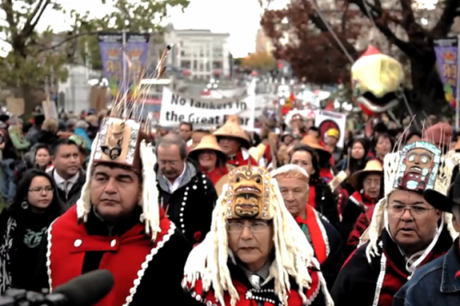by Mychaylo Prystupa / vancouverobserver

Enbridge’s $6.5 billion Northern Gateway project in particular appears to be at risk, according to several observers, due to heavy opposition in communities.
“Hundreds of people call me asking, ‘where do we go to stand in front of the bulldozers to stop Northern Gateway?’” said Art Sterritt, Executive Director at Coastal First Nations on Monday.
Even if approved by Harper’s cabinet later this year, the project could face years of court challenges.
“The project is in deep trouble — the opposition to it on environmental grounds, and the first nations objections are deeply embedded,” said Doug McArthur, a senior public policy professor at Simon Fraser University.
Eastward shift?
Last week, TransCanada filed its Energy East pipeline description with the National Energy Board. The $12 billion pipeline — the most expensive in Canada — would flow Alberta oil 4,500 km to eastern refineries and Atlantic export terminals, instead of the much shorter distance to B.C.’s Pacific coast.
Likewise, in the same week, Enbridge also announced a $7 billion upgrade to its Line 3 to double the oil pipeline’s eastward flow from Alberta to Wisconsin.
“As [pipeline companies] get blocked in a particular direction…it’s almost like water – they just keep trying to flow it in different directions,” said Sterritt.
Both companies maintain the projects are needed. Enbridge said in a statement a replacement of its 46-year-old Line 3 is required, and TransCanada said Energy East meets a huge market demand in Eastern Canada.
Refineries in Quebec and New Brunswick want a stable and low cost supply of Canadian crude, said Energy East’s spokesperson. Currently, those refineries import about 80 percent of their oil to make fuels.
“Alberta is the third largest stock of oil in the world. It only makes sense that Canadians out east benefit from our own natural resources,” said TransCanada’s Philippe Cannon in Montreal.
B.C. ‘wall of opposition’
Still, the apparent “eastward” shift in pipeline proposals has B.C. opponents celebrating.
“It’s stark evidence that unresolved Aboriginal title in British Columbia is a show stopper,” said B.C. Grand Chief Stewart Phillip on Monday.
Opposition has been building in the province for years. Thousands have attended dozens of “Defend Our Coast” rallies for example, and a recent Aboriginal campaign — Hold the Wall — collected more than 20,000 signatures.
“These are not just radical environmentalists. We’re talking about regular British Columbians – mothers, fathers, grandparents, just good normal people – who fundamentally disagree with this being the right way forward…” said Ben West, with ForestEthics Advocacy.
Though favoured by pundits to succeed, Kinder Morgan’s TransMountain expansion pipeline to Burnaby is also facing fierce scrutiny.
More than 2,000 participants have signed up to participate in an upcoming federal hearing into the project — the majority — including parent groups, politicians and scientists — are expected to oppose the project.
The company states it has engaged extensively with landowners, Aboriginal groups, communities and stakeholders.
Easier ride eastward?
University of Calgary petroleum lands management professor Robert Schulz expects TransCanada will have an easier time selling Energy East with First Nations than Enbridge has experienced with Northern Gateway.
Many Aboriginal communities already receive TransCanada revenues from an existing natural gas pipeline that would be converted for oil.
“The bands are already receiving money. So the negotiations would be, ‘ok… we signed an agreement in 1960 or whatever, and here we are 50 years later, we want to charge a little more for the oil going through,” said Schulz.
TransCanada said it is well on its way to securing partnerships with the 187 First Nations and Metis communities its project touches.
“We have close to 50 letters of agreement. We’re committed to engaging with them, and engaging in a fulsome and respectful dialogue,” said Cannon.
TransCanada held more than 60 public open houses last year, spreading its job creation and pipeline safety message. The company expects to create 10,000 construction jobs, and 1,000 permanent jobs.
Pipeline pressure
But eastern environmentalists have been stepping up the pressure too.
One group — “Save Canada” — has its members disguise themselves as TransCanada spokespeople at Energy East public engagement events, to inform people of pipeline spill risks.
Toronto-based Environmental Defence also has a petition urging the Ontario Energy Board to say no to the Energy East pipeline.
Others worry about the marine impacts of Atlantic shipments of tar sands oil.
“To export with multiple tankers through the Bay of Fundy, a world heritage site, with the most dynamic tides in the world, and full of whales and other marine mammals — it’s a dangerous proposition,” said John Bennett, with the Sierra Club Foundation in Ottawa.
Tar Sands “doubling”
The Alberta Energy department said oil sands production will double from its current 2 million barrels of oil per day to 3.8 million by 2022.
But the rapid expansion won’t be possible without the construction of major oil pipelines to carry the product. There are five major proposals underway now.
“Most people would say, you need all the pipelines and rail in order to handle the capacity of what could be produced out of the oil sands,” said Shultz in Calgary.
Energy East would not only pump Alberta oil.
TransCanada said the pipeline would also draw Bakken oil from Saskatchewan and Manitoba — an area experiencing its own “oil boom” at the moment.

